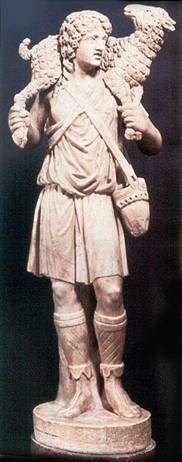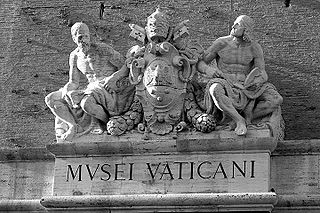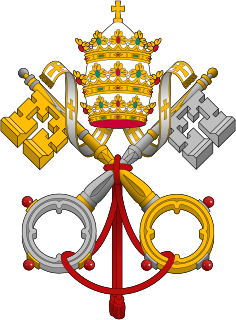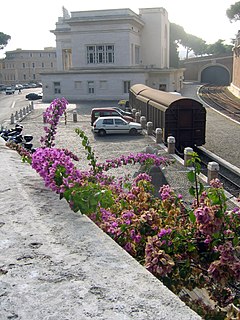

The Pio Cristiano Museum is one of the Vatican Museums. It houses various works of Christian antiquity. [1]
The museum was founded by Pope Pius IX in 1854, [2] two years after the establishment of the Pontifical Commission for Sacred Archaeology.


The Pio Cristiano Museum is one of the Vatican Museums. It houses various works of Christian antiquity. [1]
The museum was founded by Pope Pius IX in 1854, [2] two years after the establishment of the Pontifical Commission for Sacred Archaeology.
| Wikimedia Commons has media related to Museo Pio Cristiano . |
Coordinates: 41°54′23″N12°27′14″E / 41.9065°N 12.4538°E
| This article about a museum in Italy is a stub. You can help Wikipedia by expanding it. |

Pope Pius XII, born Eugenio Maria Giuseppe Giovanni Pacelli, was head of the Catholic Church and sovereign of the Vatican City State from 2 March 1939 to 1958 when he died. Before his election to the papacy, he served as secretary of the Department of Extraordinary Ecclesiastical Affairs, papal nuncio to Germany, and Cardinal Secretary of State, in which capacity he worked to conclude treaties with European and Latin American nations, such as the Reichskonkordat with Nazi Germany.
The Roman Curia comprises the administrative institutions of the Holy See and the central body through which the affairs of the Catholic Church are conducted. It acts in the Pope's name and with his authority for the good and for the service of the particular churches and provides the central organization for the church to advance its objectives.

Vatican City, officially Vatican City State, is an independent city-state enclaved within Rome, Italy. Established with the Lateran Treaty (1929), it is distinct from, yet under "full ownership, exclusive dominion, and sovereign authority and jurisdiction" of the Holy See. With an area of 49 hectares and a population of about 825, it is the smallest sovereign state in the world by both area and population.

Sacrosanctum Concilium, the Constitution on the Sacred Liturgy, is one of the constitutions of the Second Vatican Council. It was approved by the assembled bishops by a vote of 2,147 to 4 and promulgated by Pope Paul VI on 4 December 1963. The main aim was to achieve greater lay participation in the Catholic Church's liturgy. The title is taken from the opening lines of the document and means "this Sacred Council".

The flag of Vatican City was adopted on 7 June 1929, the year Pope Pius XI signed the Lateran Treaty with Italy, creating a new independent state governed by the Holy See. The Vatican flag is modeled on the 1808 yellow and white flag of the earlier Papal States, to which a papal tiara and keys were later added. The Vatican also refer to it, interchangeably, as the flag of the Holy See.

The Vatican Museums are the public art and sculpture museums in the Vatican City. They display works from the immense collection amassed by the Roman Catholic Church and the Papacy throughout the centuries including several of the most renowned Roman sculptures and most important masterpieces of Renaissance art in the world. The museums contain roughly 70,000 works, of which 20,000 are on display, and currently employ 640 people who work in 40 different administrative, scholarly, and restoration departments.
A concordat is a convention between the Holy See and a sovereign state that defines the relationship between the Catholic Church and the state in matters that concern both, i.e. the recognition and privileges of the Catholic Church in a particular country and with secular matters that impact on church interests.

Saint Peter's tomb is a site under St. Peter's Basilica that includes several graves and a structure said by Vatican authorities to have been built to memorialize the location of Saint Peter's grave. St. Peter's tomb is near the west end of a complex of mausoleums that date between about AD 130 and AD 300. The complex was partially torn down and filled with earth to provide a foundation for the building of the first St. Peter's Basilica during the reign of Constantine I in about AD 330. Though many bones have been found at the site of the 2nd-century shrine, as the result of two campaigns of archaeological excavation, Pope Pius XII stated in December 1950 that none could be confirmed to be Saint Peter's with absolute certainty. Following the discovery of bones that had been transferred from a second tomb under the monument, on June 26, 1968, Pope Paul VI said that the relics of Saint Peter had been identified in a manner considered convincing.

The Pontifical Academy of Sciences is a scientific academy of the Vatican City, established in 1936 by Pope Pius XI, and thriving with the blessing of the Papacy ever since. Its aim is to promote the progress of the mathematical, physical, and natural sciences and the study of related epistemological problems. The Academy has its origins in the Accademia Pontificia dei Nuovi Lincei, founded in 1847 as a more closely supervised successor to the Accademia dei Lincei established in Rome in 1603 by the learned Roman Prince, Federico Cesi (1585–1630), who was a young botanist and naturalist, and which claimed Galileo Galilei as its president. The Accademia dei Lincei survives as a wholly separate institution.

The Cappella Paolina is a chapel in the Apostolic Palace, Vatican City. It is separated from the Sistine Chapel by the Sala Regia. It is not on any of the regular tourist itineraries.

The Column of Antoninus Pius is a Roman honorific column in Rome, Italy, devoted in AD 161 to the Roman emperor Antoninus Pius, in the Campus Martius, on the edge of the hill now known as Monte Citorio, and set up by his successors, the co-emperors Marcus Aurelius and Lucius Verus.

The Casina Pio IV is a patrician villa in Vatican City which is now home to the Pontifical Academy of Sciences, the Pontifical Academy of Social Sciences and the Pontifical Academy of St. Thomas Aquinas. The predecessor of the present complex structure was begun in the spring of 1558 by Pope Paul IV in the Vatican Gardens, west of the Cortile del Belvedere. Paul IV commissioned the initial project of the 'Casina del Boschetto', as it was originally called, from an unknown architect; the first mention of the single-storey building can be found on 30 April 1558, and a notice of the following 6 May, says that the Pope spent "two thirds of his time at the Belvedere, where he has begun to build a fountain in the woods".

The Vatican Railway was opened in 1934 to serve Vatican City and its only station, Vatican City. The main rail tracks are standard gauge and 300 metres (980 ft) long, with two freight sidings, making it the shortest national railway system in the world. Access to the Italian rail network is over a viaduct to Roma San Pietro railway station, and is guaranteed by the Lateran Treaty dating from 1929. The tracks and station were constructed during the reign of Pope Pius XI, shortly after the treaty.

The Pontifical Latin American College is one of the Roman Colleges of the Roman Catholic Church, for students from Central and South America. A pontifical college in Rome is a hostel for student priests who pursue higher ecclesiastical studies in various Church universities and institutes.

The Collection of Modern Religious Art of the Vatican Museums is a collection of paintings, graphic art and sculptures. It occupies 55 rooms: the Borgia Apartment on the first floor of the Apostolic Palace, the two floors of the Salette Borgia, a series of rooms below the Sistine Chapel, and a series of rooms on the ground floor.

The Gardens of Vatican City, also informally known as the Vatican Gardens in Vatican City, are private urban gardens and parks which cover more than half of the country, located in the west of the territory and owned by the Pope. There are some buildings, such as Radio Vatican and the Governor's Palace, within the gardens.

The Pontifical Academy of Fine Arts and Letters of the Virtuosi al Pantheon is one of the Pontifical Academies under the direction of the Holy See. The complete Italian name of the academy, Pontificia Insigne Accademia di Belle Arti e Letteratura dei Virtuosi al Pantheon, includes the adjective insigne (illustrious), often omitted in official English translations. The term Virtuosi al Pantheon is also usually left untranslated, but, in any event, should not be taken in the English musical sense of “virtuoso” but rather “artists of great merit”. The Pantheon in Rome was the historical home of the academy. The term “academy” is meant in the Renaissance definition of the term as an association of learned persons and not an institution of instruction.

The Church of Saints Martin and Sebastian of the Swiss is a Roman Catholic oratory in Vatican City. The church was built by Pope Pius V in 1568 to serve as a private chapel for the Pontifical Swiss Guards, whose barracks are located next to Porta San Pellegrino, close to the Apostolic Palace. It is considered the national church of Switzerland in Rome.
Bramante Staircase is the name given to two staircases in the Vatican Museums in the Vatican City State: the original stair, built in 1505, and a modern equivalent from 1932.
Vatican City has become one of the world's most striking architecture through several centuries and a world cultural heritage. The area of the Vatican is small, which is made up of several famous landmarks. The architecture of Vatican City, dominated by religious architecture, is characterized by several architectural styles such as Roman, Baroque, and Gothic with the different time, most representative the buildings are concentrated in the medieval period and the 16th–18th century.